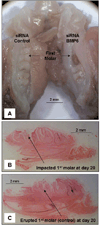Requirement of alveolar bone formation for eruption of rat molars
- PMID: 21896048
- PMCID: PMC3170088
- DOI: 10.1111/j.1600-0722.2011.00854.x
Requirement of alveolar bone formation for eruption of rat molars
Abstract
Tooth eruption is a localized event that requires a dental follicle (DF) to regulate the resorption of alveolar bone to form an eruption pathway. During the intra-osseous phase of eruption, the tooth moves through this pathway. The mechanism or motive force that propels the tooth through this pathway is controversial but many studies have shown that alveolar bone growth at the base of the crypt occurs during eruption. To determine if this bone growth (osteogenesis) was causal, experiments were designed in which the expression of an osteogenic gene in the DF, bone morphogenetic protein-6 (Bmp6), was inhibited by injection of the first mandibular molar of the rat with a small interfering RNA (siRNA) targeted against Bmp6. The injection was followed by electroporation to promote uptake of the siRNA. In 45 first molars injected, eruption was either delayed or completely inhibited (seven molars). In the impacted molars, an eruption pathway formed but bone growth at the base of the crypt was greatly reduced compared with the erupted first-molar controls. These studies show that alveolar bone growth at the base of the crypt is required for tooth eruption and that Bmp6 may be essential for promoting this growth.
© 2011 Eur J Oral Sci.
Conflict of interest statement
Figures





References
-
- Cahill DR, Marks SC., Jr Tooth eruption: evidence for the central role of the dental follicle. J Oral Pathol. 1980;9:189–200. - PubMed
-
- Marks SC., Jr Pathogenesis of osteopetrosis in the ia rat: reduced bone resorption due to reduced osteoclast function. Am J Anat. 1973;138:165–189. - PubMed
-
- Cotton WR, Gaines JF. Unerupted dentition secondary to congenital osteopetrosis in the Osborne-Mendel rat. Proc Soc Exp Biol Med. 1974;146:554–561. - PubMed
Publication types
MeSH terms
Substances
Grants and funding
LinkOut - more resources
Full Text Sources
Miscellaneous

